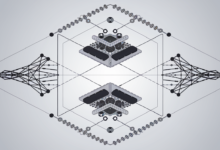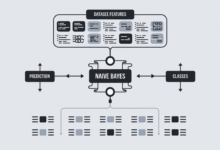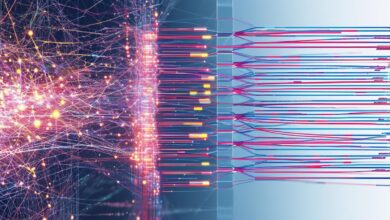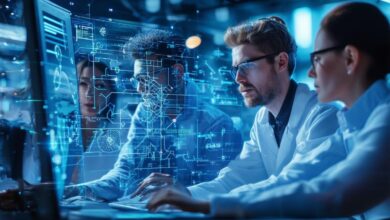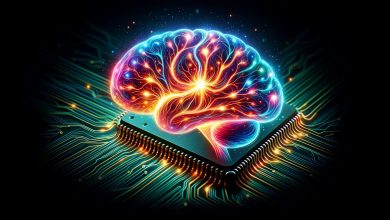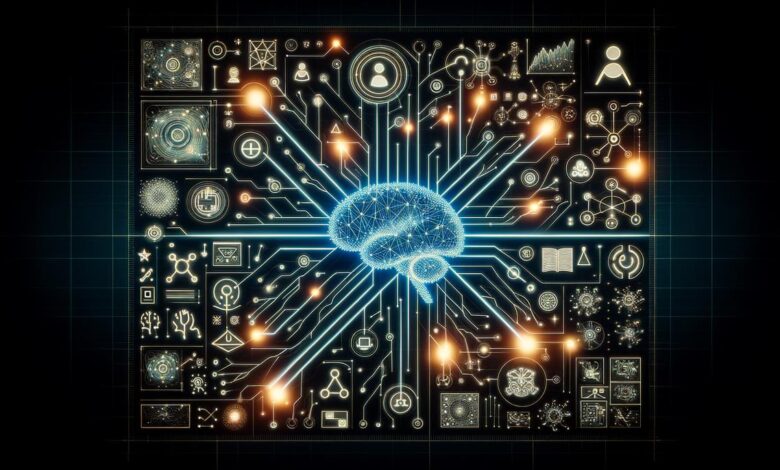
Understanding Deep Learning
Deep learning, a branch of machine learning, utilizes multiple layers of nodes to simulate the decision-making processes of the human brain. These nodes act like neurons, transmitting data across various layers to extract features, recognize patterns, and make decisions. This multi-layered approach helps systems identify complex representations in raw data, increasing their proficiency without manual intervention.
Deep learning excels with unstructured data like images or text, handling real-world data types directly, often leading to better outcomes. Instead of predetermined features, the algorithm identifies and learns elements like dogs or cars through layers of convolution operations.
Traditional machine learning requires structured, labeled datasets. Features are manually extracted before driving predictions or classifications, limiting the algorithm's ability to handle unexpected data variations, an area where deep learning shines.
Artificial neural networks (ANNs) consist of input, hidden, and output layers. Input layers receive raw data, hidden layers process it through transformations, and output layers produce decisions or predictions. These models learn and adjust through backpropagation, where errors are calculated, and adjustments enhance accuracy over cycles.
Deep learning can operate without explicit rules or labels, independently learning patterns and correlations from data. It incorporates supervised, unsupervised, and reinforcement learning techniques across diverse applications like healthcare diagnostics, autonomous driving, and customer service.
Specialized architectures like convolutional neural networks (CNNs) and recurrent neural networks (RNNs) further extend deep learning's capabilities. CNNs excel at image-related tasks, while RNNs handle sequential data like speech or text, highlighting deep learning's adaptability in solving complex, domain-specific challenges.
Types of Neural Networks
Feedforward Neural Networks (FNNs) represent the simplest form, with data moving in one direction from input to output through hidden layers. They handle basic classification, pattern recognition, and regression tasks efficiently.
Convolutional Neural Networks (CNNs) are designed for grid-like data like images. They include:
- Convolutional layers that apply filters to capture features like edges and textures
- Pooling layers that reduce dimensionality
- Fully connected layers that consolidate features for predictions or classifications
CNNs excel in visual tasks like object detection and facial recognition.
Recurrent Neural Networks (RNNs) handle sequential data, making them invaluable for time-series predictions and natural language processing (NLP). They have loops that allow information to be passed from one step to the next, providing context. Advanced versions like Long Short-Term Memory Networks (LSTMs) and Gated Recurrent Units (GRUs) use gating mechanisms to manage long-term dependencies, improving performance in tasks like speech recognition and language translation.
These specialized networks—FNNs, CNNs, and RNNs—allow deep learning to adapt to various challenges, driving advancements across sectors.
Deep Learning Algorithms
Convolutional Neural Networks (CNNs) are designed for image data, excelling in tasks like object detection and facial recognition. They comprise convolutional layers that apply filters to detect features, pooling layers that reduce dimensionality, and fully connected layers for final predictions.
Recurrent Neural Networks (RNNs) are tailored for sequential data, adept at processing time-series and natural language. Advanced variants like Long Short-Term Memory Networks (LSTMs) include mechanisms like gates to control information flow, retaining context over longer sequences.
Generative Adversarial Networks (GANs) consist of two neural networks, a generator and a discriminator, engaged in a competitive learning process. The generator creates fake data, while the discriminator distinguishes between real and fake, improving the generator over time.
Autoencoders are used for data compression and dimensionality reduction by encoding input data into a lower-dimensional representation and decoding it back. They are useful in tasks like anomaly detection.
Deep Q-Networks (DQNs) combine deep learning with reinforcement learning to handle environments with high-dimensional space, notably employed in game playing scenarios.
Variational Autoencoders (VAEs) extend conventional autoencoders by incorporating probabilistic methods, outputting probability distributions in the latent space, suitable for creative tasks like generating new artwork.
Graph Neural Networks (GNNs) cater to graph-structured data, passing information through nodes and edges to capture relationships and dependencies within complex datasets.
Transformer Networks have revolutionized natural language processing, using self-attention mechanisms to process sequences in parallel, excelling in tasks like text generation and machine translation.
Deep Belief Networks (DBNs) consist of multiple layers of stochastic, hidden variables, trained layer by layer for feature extraction and dimensionality reduction.
These algorithms showcase the adaptability and power of neural networks in addressing complex tasks across domains, driving innovation and solution development in real-world scenarios.
Applications of Deep Learning
Deep learning has made significant strides across numerous industries, seamlessly integrating into various applications. In healthcare, it facilitates early disease detection and diagnosis. Convolutional neural networks (CNNs) analyze medical images with remarkable precision, identifying anomalies that might be missed by the human eye. Deep learning models also predict patient outcomes by interpreting vast datasets, enabling personalized medical care.
In finance, deep learning enhances security and efficiency. It aids fraud detection, where models identify unusual patterns indicating fraudulent activities. Deep learning also assists in algorithmic trading by analyzing market trends and predicting stock performance, enabling data-driven investment decisions.
Customer service has transformed through chatbots and virtual assistants powered by deep learning. These AI-driven interfaces leverage natural language processing (NLP) to provide accurate responses to customer inquiries, making interactions feel personal and efficient.
Autonomous driving is another field where deep learning has demonstrated transformative potential. Self-driving cars utilize deep reinforcement learning to navigate complex road scenarios safely. CNNs process visual and spatial data to detect and recognize objects, while recurrent neural networks (RNNs) handle driving's temporal aspects.
Deep learning is pivotal in speech recognition and generation applications. Virtual assistants employ deep learning for accurate voice command interpretation and response, enabling functionalities like setting reminders and controlling smart home devices.
Deep learning's impact spans various industries, bringing advancements in healthcare diagnostics, financial security, customer service automation, and autonomous driving. Its ability to process and learn from unstructured data enables innovative solutions and enhances operational efficiency across multiple domains.
Challenges and Advantages
Deep learning offers impressive advantages, positioning it as a game-changer. One key benefit is its high accuracy, often outperforming traditional machine learning models in tasks requiring complex data analysis and pattern recognition.
Another significant advantage is automated feature engineering. Deep learning models can automatically uncover significant features from datasets during training, streamlining the development pipeline and enhancing adaptability across diverse tasks and datasets.
However, deep learning comes with its own set of challenges. Data availability is a pressing issue, as these models require vast amounts of data to achieve optimal performance. Obtaining labeled data necessary for supervised learning adds another layer of complexity.
The computational resources required for deep learning are another substantial challenge. These models demand high-powered hardware due to their intensive mathematical computations, making it prohibitive for organizations with limited access to advanced computing infrastructure.
Interpretability remains a critical challenge in deep learning. The "black box" nature of deep neural networks makes it difficult to understand and explain their decision-making process, which is crucial in sensitive fields like healthcare and finance.
Balancing these advantages with the inherent challenges provides a nuanced view of deep learning. While the technology has tremendous potential, it is essential to address the issues of data availability, computational requirements, and interpretability to unlock its full capabilities responsibly.
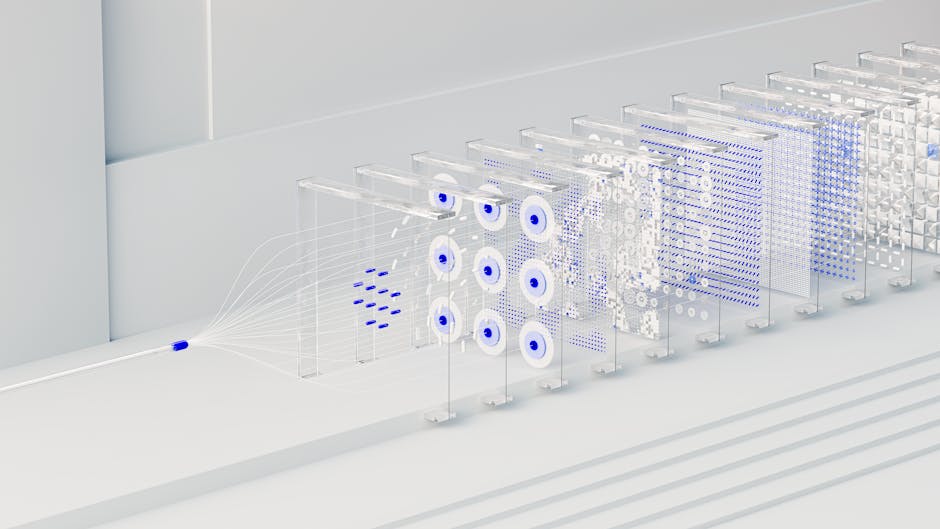
Future Trends in Deep Learning
The future of deep learning is poised to drive remarkable advancements across multiple domains, underpinned by innovations in hardware, algorithms, and novel applications.
A significant trend is the development of more efficient and powerful hardware designed for deep learning requirements, such as Tensor Processing Units (TPUs) and custom AI chips. These advancements will facilitate faster training times, reduced energy consumption, and the ability to handle increasingly larger datasets.
Algorithmic innovation is another driving force, with research into attention mechanisms, transformers, and neural architecture search (NAS) aiming to automate the design of neural networks and optimize architectures for specific tasks.
Emerging applications of deep learning are likely to transform numerous industries, leveraging its capability to process and analyze vast amounts of unstructured data. In healthcare, advancements in personalized medicine will rely heavily on deep learning, while environmental sciences will benefit from AI in climate modeling.
Another area seeing rapid progress is integrating deep learning with edge computing, enabling real-time data processing and decision-making on devices like smartphones, IoT devices, and autonomous drones.
Ethical considerations and interpretability will also shape deep learning's future trajectory. Efforts to develop explainable AI (XAI) and mitigate biases within datasets and models will continue to ensure AI systems operate transparently, fairly, and accountably.
In summary, deep learning's trajectory is set on an upward curve, driven by breakthroughs in hardware, revolutionary algorithms, and an expanding array of applications. As AI's integration into everyday life becomes more seamless, deep learning will considerably augment human capabilities and societal progress.

Deep learning's ability to process unstructured data, perform unsupervised learning, and refine through layers of transformations propels it beyond conventional algorithms. It transforms raw data into actionable insights, mimicking the cognitive functions of the human brain, and opening doors to innovative solutions in varied fields.
